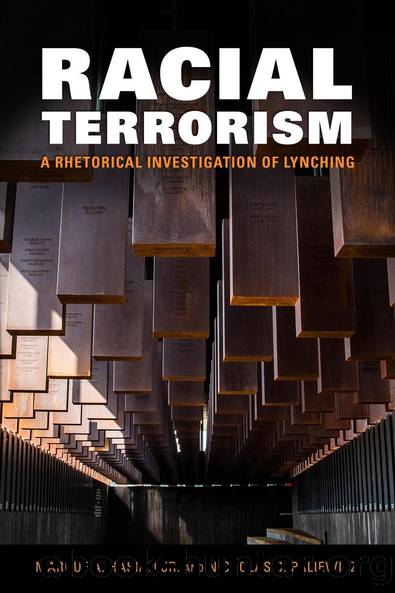Racial Terrorism by Marouf A. Hasian Nicholas S. Paliewicz

Author:Marouf A. Hasian, Nicholas S. Paliewicz [Marouf A. Hasian, Nicholas S. Paliewicz]
Language: eng
Format: epub
Tags: Social Science, Discrimination, Language Arts & Disciplines, Rhetoric, Ethnic Studies, American, African American & Black Studies, History, United States, State & Local, South (AL; AR; FL; GA; KY; LA; MS; NC; SC; TN; VA; WV)
ISBN: 9781496831781
Google: bdAMEAAAQBAJ
Publisher: Univ. Press of Mississippi
Published: 2020-12-28T03:19:48+00:00
Figure 2: Lurleen B. Wallace Office Building, Montgomery, Alabama. Photo by the authors.
Keep in mind Schmidtâs critique in realizing that the state of Alabama has 121 monuments to the Confederacy, and that relics of this Confederate past are located in schools, public buildings and offices, and memorials and museums.18 This is one of the reasons why in chapter 5 we underscored the point that Bryan Stevensonâs and the EJIâs historicizing is not the only âhistoryâ of fraught Southern pasts.
When one travels to the National Memorial for Peace and Justice and the Legacy Museum, one cannot help noticing this surplus of Confederate symbolism, and the surfeit of memories, that have become indelible parts of the cityscapes of Montgomery and the state of Alabama. Observable from the apex of the Lynching Memorial, for instance, is the Alabama State Capitol, a structure glossed with white paint and surrounded by memorials to former Confederate soldiers. Across the street is the Lurleen B. Wallace Office Building, named after the forty-sixth governor of Alabama, who succeeded her infamous husband, George Wallace (fig. 2).
It is also hard to miss the eighty-eight-foot-tall Confederate Monument, mentioned above, which commemorates the fallen Confederate soldiers who fought the âWar of Northern Aggression.â From an interpellation standpoint, how can visitors avoid being âhailedâ as they walk up and down a grand staircase that appears directly in front of the capitol? In these politicized webs of signification, to be Southern, or to be American in this part of the country, is to be immersed in Dixie life. The EJIâs works must sense that visible and invisible inclusionary and exclusionary boundaries are being constructed through bricks and mortar and these Confederate ideological assemblages.
Download
This site does not store any files on its server. We only index and link to content provided by other sites. Please contact the content providers to delete copyright contents if any and email us, we'll remove relevant links or contents immediately.
Cecilia; Or, Memoirs of an Heiress — Volume 1 by Fanny Burney(32357)
Cecilia; Or, Memoirs of an Heiress — Volume 3 by Fanny Burney(31727)
Cecilia; Or, Memoirs of an Heiress — Volume 2 by Fanny Burney(31701)
The Lost Art of Listening by Michael P. Nichols(7347)
Asking the Right Questions: A Guide to Critical Thinking by M. Neil Browne & Stuart M. Keeley(5565)
We Need to Talk by Celeste Headlee(5481)
On Writing A Memoir of the Craft by Stephen King(4809)
Dialogue by Robert McKee(4263)
Pre-Suasion: A Revolutionary Way to Influence and Persuade by Robert Cialdini(4080)
I Have Something to Say: Mastering the Art of Public Speaking in an Age of Disconnection by John Bowe(3807)
Elements of Style 2017 by Richard De A'Morelli(3271)
The Book of Human Emotions by Tiffany Watt Smith(3187)
Fluent Forever: How to Learn Any Language Fast and Never Forget It by Gabriel Wyner(2969)
Name Book, The: Over 10,000 Names--Their Meanings, Origins, and Spiritual Significance by Astoria Dorothy(2900)
Good Humor, Bad Taste: A Sociology of the Joke by Kuipers Giselinde(2845)
Why I Write by George Orwell(2843)
The Grammaring Guide to English Grammar with Exercises by Péter Simon(2671)
The Art Of Deception by Kevin Mitnick(2652)
Ancient Worlds by Michael Scott(2567)
